How Long Should Dress Pants Be? Pant Breaks Style Guide
/.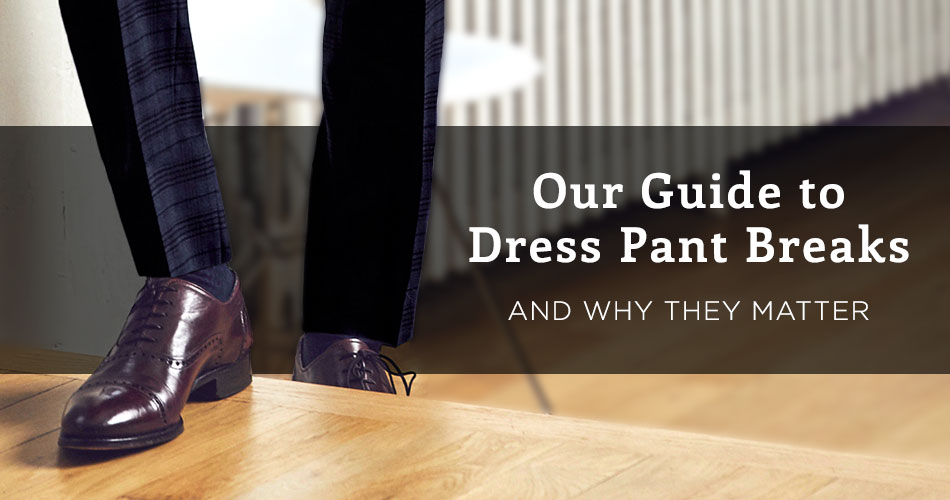
Our Guide to Dress Pant Breaks And Why They Matter
Dress pant breaks (how your pant fabric drapes when it sits atop your dress shoes), like so many elements of style, are mainly a matter of personal preference.
That being said, the wrong dress pant break won’t flatter your body type, might not make the statement you think it does, and may not be appropriate for the environment or occasion. The biggest mistake is failing to make an intentional choice. If dress pant breaks are tripping you up, here’s what you need to know.
What is The Pant Break?
Our journey to perfectly fitting pants starts with a quick stop by the tailoring dictionary.
The “break” of the pant is the fold or creasing of fabric that forms at the front of your pant leg, just above where it meets your shoe. More simply, it’s the areas on your pant where the front crease does not drape naturally. Note that dress pant breaks should only be defined from a natural, standing pose.
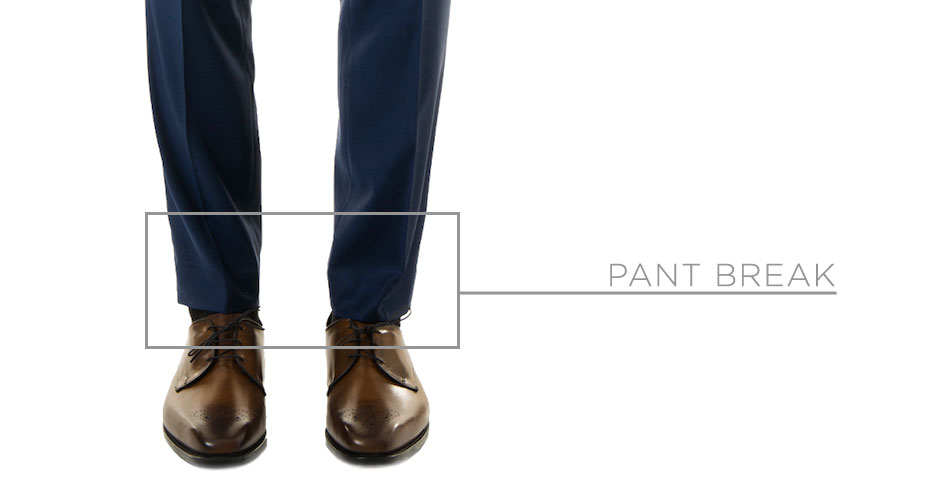
Among the factors that affects dress pant breaks are the taper (that’s the narrowing of your pants towards the leg opening) and the length (formally referred to as the inseam or outseam measurement).
Generally speaking, a longer dress pant will have a “heavier” break, meaning more creasing and folding atop the shoe. While that seems like common sense, you might be surprised to hear that wider pants typically lead to less break. That’s because the wider the circumference of your leg opening, the more room your pant fabric has to drape naturally. As a result, your trouser break will be less defined. Slimmer leg openings, on the other hand, will constrict the fabric against the leg, breaking the pant higher up the leg.
All this is to remind you that if you like wearing slimmer pants, the pant legs may need to be a bit shorter to accommodate your preferred trouser break. More on that below.
How long should dress pants be, then?
To answer directly, the most commonly recommended dress pant break for most occasions is the half break, or medium break, because it looks fairly traditional without appearing messy or disheveled (read more at #2 below). However, it’s important to note that rules surrounding how a dress pant break should look are dependant upon many factors, including the formality of the occasion, personal taste, and even fabric. With that in mind, ask yourself the following considerations to help determine your preferred dress pant break:
- How do the pants fit?
- Do the pants have a narrow or wide leg opening?
- Where do you plan to wear the suit/dress pants?
- What image do you want to convey?
The answers to these questions will dictate the optimal pant break for you. To help communicate this preference, we’ll define the four types of dress pant break below: no break pants, quarter break pants, half (or medium) break pants, and full break pants.
Let’s dive in.
1. No Break Pants
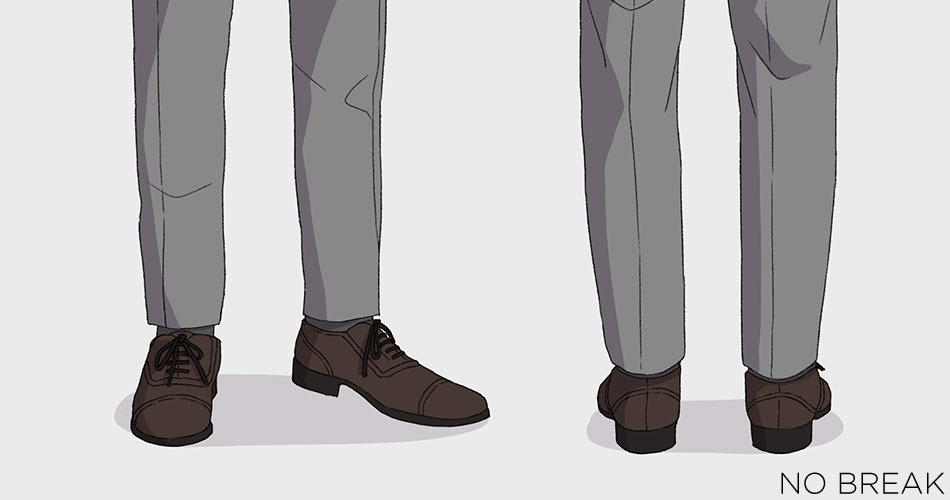
No break pants offer a sharp, modern and minimalist aesthetic and are considered the most trendy style of dress pant break. With a breakless look, your style will be perceived as youthful, trendy and bold. For those working in creative fields or hip start-up offices, and young gentlemen that just enjoy suiting up when hitting the town, that works in your favor. If your workplace is more conservative, pants with no break could come off as aggressively showy to colleagues and clients, and might distract people from whom you wish to earn (or demand) respect. Even worse—no break pants at a funeral or other solemn event could be perceived as disrespectful.
For what it’s worth, no break pants have a lot of fans here at Black Lapel HQ.
How It Looks
“No break” means the hem of your pants will sit just above your shoe. The no break look works best on slimmer body types or men who are above average in height. That’s because despite a cleaner silhouette, from certain angles (particularly the back and to a lesser extent, from the side), the pant legs can appear shorter and therefore further the appearance of shorter, thicker legs.
If you’re going to give this look a try, just make sure that they aren’t hemmed too short or you’ll look like you’re preparing for a flood or you accidentally shrunk your pants in your dryer. One more important note – this look will reveal more of your socks than any other pant break style for obvious reasons. That means you’ll want to make sure your sock game is on point because they’ll get plenty of visibility.
Lastly, it’s important to consider fabric when chosing this style. A heavier wool pant would be incongruous with a no break style, whereas a light linen or seersucker pant for summer begs to show a little ankle!
The Pant Cut
Pants with no break work best with a fit that is slim and strongly tapered. You won’t want to walk and have wide leg openings looking like sails billowing back and forth as you stride.
The Cropped Pant
While the no break definition includes any pant that breaks above the shoe, we’d be remiss not to share what many consider to be the fifth style of pant break: the cropped pant. Put back into the zeitgeist by high-end designers like Thom Browne, a cropped pant sits well above the shoe, exposing your ankles. It is typically paired with low or loafer style shoe worn with no-show socks (or no socks at all).
No Break Summary:
- Pant hem just reaches but does not rest on the top of the dress shoe
- Better with slim, tapered pants and lighter weight fabrics.
- The modern look that gives off a youthful, bold and trendy vibe
- Easier to pull off for slimmer and/or taller gents
2. Quarter Break Pants

While we appreciate the boldness of pants with no break, we know that the boldness of youthful style isn’t for everyone. The next type of dress pant break is the quarter break, an updated classic that is flattering on a wide range of body types and brings a slight touch of modern style to your trousers.
How It Looks
The hem of a quarter break pant will sit just past where your pant legs meet your shoe with minimal contact. This option is modern, tasteful but not flashy, and shows you care about staying up-to-date yet still respect tradition. Ideal for the modern businessman, quarter break pants let everyone know that you’re trying, but not trying too hard, and that attitude looks good on everyone.
The Pant Cut
Quarter breaks are most appropriate for pants that are moderately slim, and work with any type of fabric choice. Like the no break look, quarter breaks are easier to pull off for those that are taller or slimmer.
Quarter Break Pant Summary:
- Fabric rests slightly on the top of the shoe
- Best with slim to moderately slim pants
- A modern look that does not disrespect more formal occasions
- Easier to pull off for slimmer and/or taller gents
3. Half Break Pants
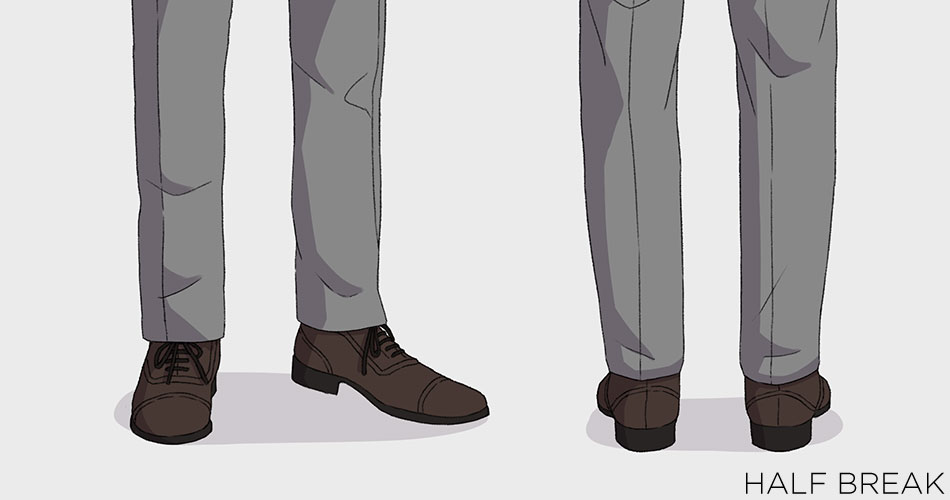
As we move down the list towards the more conservative side of the spectrum, we arrive at the half break. You might also hear this referred to as a medium break. While it won’t earn you points from dandy modernists, it also won’t ruffle traditionalist feathers either. Sometimes, that’s exactly what certain offices, clients and occasions need – a classic option that works in all contexts.
If you’re unsure of your preference and just want to start somewhere, this is the pant dress break for you. You’ll look clean, not disheveled, and you won’t offend any person or occasion.
How It Looks
The hem of your pants with a half break should sit ½ – ¾” of the way down past the point where your pants first meet your shoes. This allows for a slight horizontal fold to make contact with the front of your shoes, creating the break.
The Pant Cut
Given its versatility, the half break look can work with most pant fits, from slim to straight and even relaxed. Men who are shorter will benefit in particular from a combination of a slimmer fit and the slightly longer length, which can help create an elongating visual effect.
Get the fit right on the rest of the pants (we always suggest going custom) and a half break will look clean, polished and classically well-dressed on just about everyone.
Half Break Pant Summary:
- Pant hem makes solid contact with the front of the shoe and forms a slightly visible wrinkle
- Works most pant fits and fabric types
- A versatile option that works in any context
- Works for men of any build or height but particularly effective for shorter gents
4. Full Break Pants
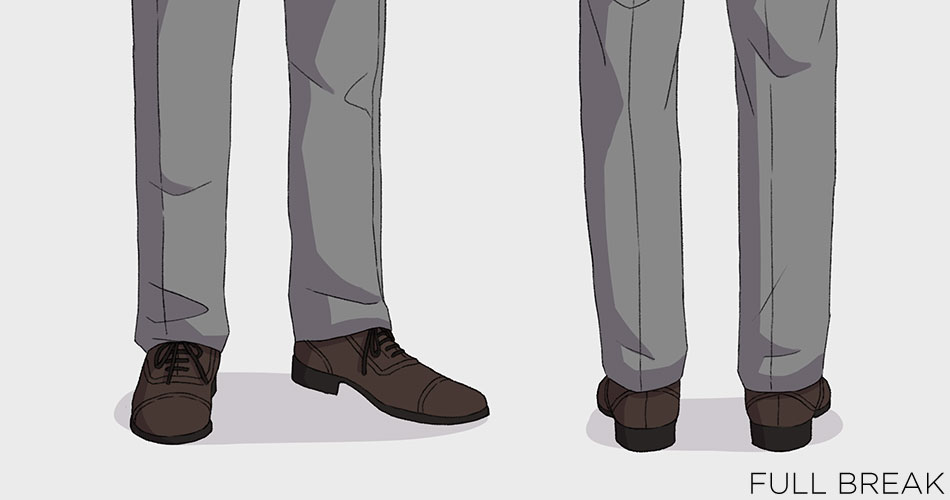
The last style to cover is the most conservative look you could ask for — the full break. The full break is a great look for older gentlemen or those who like a classic look. Notably, this variation was far more prevalent in the pre-internet, pre-slim-fit-everything era and much less common now. This is also a very handsome style for heavier winter wool pants or pants with cuffs.
How It Looks
A full break is when the hem of your pants makes substantial contact with your shoes to the effect of creating a generous but still elegant looking ripple in the area above the hem. Since this look often pairs with pant legs that are less tapered, the longer hem will also cover most of the laces on your shoes. Be mindful that back of the hem should sit just above the heel of your shoes.
It’s important to note that pants that puddle at the hem or those that form multiple breaks/wrinkles in the area above the hem would generally be considered sloppy. Any tailor can manage a quick hem, and we highly encourage it regardless of style. Be sure the rear hem of your trouser never drags below your shoe.
The Pant Cut
With the longer, wider pant leg, this dress pant break is a great option for men who are heavier set. You can also explore this style if you intend to portray a more vintage or old-school style, or are wearing heavy winter trousers with chunky boots.
Full Break Pant Summary:
- Pant hem forms a single, generous but elegant wrinkle above where it meets the shoe, covering most of the shoelaces
- Found on straight-leg, less tapered pants
- The most conservative choice that is always office-appropriate
- Works particularly well for heavier-set gents
Want to nail your ideal dress pant break every time? Book an appointment with us, or shop online now to find your Flawless Fit.
Your Next Move:
Like What You See? There's More.
We'll send you style advice and intel for the modern man.

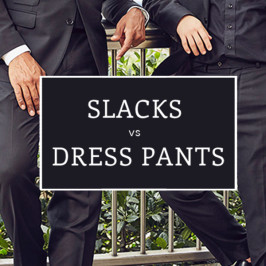
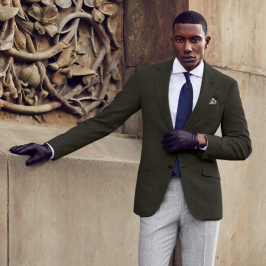
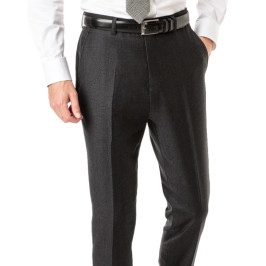
Hemmed a lot of trousers for my husband but never knew what a ‘break’ was. Now he’ll look perfect. Great style guide.
My sister wedding is about to come and i never wore a suit before ….So which pant break will suit for wedding ??
I am surprised as every site I have read says no break is best for shorter men 5ft 8″ ect…
Yet you say half break is better? for shorter guys.
Totally confused.
Regardless of the style is the hem stitched straight around horizontally or are they sewn with a taper?
My height is 165 cm and I am not slim but I am Fit which break model pant is best for me.
Hey Vijay — a quarter pant break is really a can’t-go-wrong option for anyone. Give that one a shot!
Hello-
Thank you for the rundown of the dress pants break. I’ve trended towards no break, extra slim dress pants, paired with some type of patterned button-up dress shirt for work, minus the tie. Prior to COVID I was big into making statements with the dress socks I wore.
Now that I have essentially a no break- shorter- pant leg, it’s showing more of my socks, especially when I sit down. Most of my dress socks come up to mid-calf. I’ve heard, I may be showing too much of my “statement dress socks”.
So with the no-break dress pants, should I abandon the mod-calf dress socks? Is there such a thing as short dress socks that show the ankle that is appropriate for a medical field salesperson? Maybe I need to change my dress shoes? Currently have a black and brown pair of this shoe from J&M…. https://www.johnstonmurphy.com/xc4®-stanton-run-off/6298.html?dwvar_6298_color=Black%20Waterproof%20Full%20Grain#sz=100&start=1
Please help.
JC
thanks for the info., just needed to hem my husband’s new dress pants and noticed they were more tapered at the bottom and wondered if there was a difference in hem length now. I think I will choose the half-break. He doesn’t want his socks to show and doesn’t like that look. Interesting article, glad I now know the correct style for him.
Love the breakdown! Makes it easy to understand and apply!